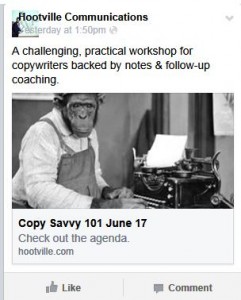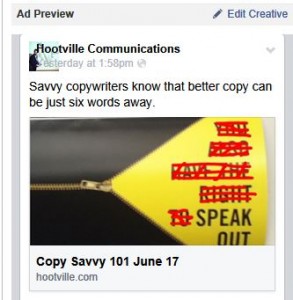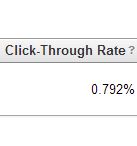Hootville continues to invest its time and dollars in Facebook advertising. Generally the results are rather good by which we mean that we are paying a pleasingly low cost for each desired action we receive. A desired action might be for a viewer of the ad to click the Like button or click through to our website or engage with the Facebook post. In other words we are getting people to interact with the ad at a low cost.
For copywriters and marketers there’s a great deal of interest in uncovering the ads which get results and those which don’t. Rarely have copywriters and marketers been able to so scientifically alter a single variable and gauge the impact.
There are three key variables with which one can play:
- The ad itself. The creative – meaning the imagery, the copywriting, the fundamental proposition, the tone.
- Audience demographics – age, location, interests, gender etc.
- Deployment of the ad – will it show on mobile devices only, desktops only, in the Newsfeed or on the right hand side?
Each of these factors can vary the results. Sometimes what we think will work, works. Sometimes it doesn’t. Changing one factor at a time allows direct comparison. Let the games begin.
We’re promoting Copy Savvy 101 (in case you don’t know) so have been running Facebook ads. This week we created two different ads which we ran simultaneously. We kept the audience demographics and deployment the same for each but the two creative approaches were entirely different.
- Who can resist monkeys doing human things? (We read his work BTW. Not much good – basically a rehash of Jungle Book.)

The audience we were targeting was people like you: 28-55, any sex, interests in marketing, nonprofits and / or small business, attractive, tertiary qualified, living in Victoria.
The ads ran on mobile devices in the Newsfeed only. The Envelope ad is based on a post we wrote long ago. We think that the image is quite strong and the copy rather clever and meaningful to copywriters. The Monkey ad was hoping to interest and disarm people with a cute image. The results were very different, so much so that we stopped running one a few days in.
OK – over to you. Which was more successful in gaining more clicks? Envelope or Monkey? Place your guess in the comments section below. Have a snap poll around the office. Alienate those which guess incorrectly. We’ll reveal the answer in 48hr.
Meanwhile read our recent Facebook advertising post, which explains more of the basics.
May 1: Winner revealed:
As you can see the Monkey should stick to writing right wing editorials for News Corp because he’s been outperformed by the envelope. As an advertiser you want to minimise your cost per click. 41c fore the envelope vs $1.12 for the monkey? Which would you rather pay to have someone click on your Facebook ad? Our state-educated maths shows that the envelope was about 60% cheaper per click than the monkey. That’s huge. But why? Here’s our best guesses:
The envelope image was somewhat intriguing. The monkey was just silly.
The copy accompanying the envelope was clever and knowing. We’ve always taken a tone that assumes Hootville’s audiences to be savvy (somewhat cynical) professionals. The copy accompanying the monkey was straight; maybe too straight.
Complications: It’s easy to assume that a lower cost per click indicates a superior creative approach but the price you pay per click isn’t the best measure the effectiveness of your creative approach. Facebook has a dynamic pricing policy akin to an auction system so the price you pay is influenced by factors beyond the appeal of your ad. Other factors include the number of other advertisers also attempting to reach your audience and how much they are willing to pay. More competition = higher cost even for the same ad.
The click through rate (CTR) is the purest way to assess how appealing / effective your creative is. This measures the percentage of people who saw your ad and then – bless them – clicked on it. Let’s compare our two ads again. Less than one in 100 people (0.792%) clicked on the monkey ad (see above). The envelope proved much more appealing with a marked difference in its power over men (1.134%) and women (1.604%). That’s a whopping 40% difference between the sexes.
Beyond ego gratification there’s another reason to aim for a higher CTR. The higher your CTR, the less you pay. Why? Facebook wants its ads clicked so it is more likely to show an ad with a high CTR for less money, to your audience, more often. Win / win. We’d love to hear of higher CTRs. And if you’ve gained from this post we’d love you to share it.
Finally; if you’ve gained from this, please share it with some friends and be sure to subscribe to our email – the Hootville Lowdown.




